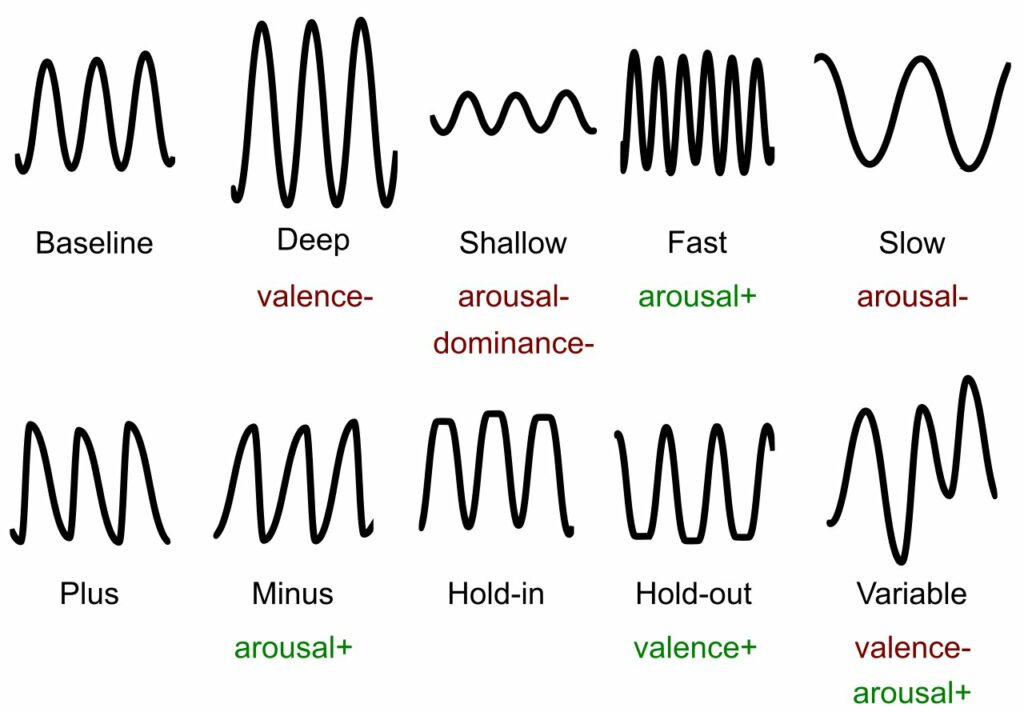Breeze is a research project conducted in collaboration with the Magic Lab laboratory from Ben Gurion University (Israel). Breeze is a necklace pendant that captures breathing from one user while conveying their breathing patterns to a paired pendant worn by another user.
The seed of this project was planted during the development of Echo, when we started to envision scenarios of biofeedback applications involving multiple users. One form factor that we considered as a follow-up of the Echo avatar was a wearable, that we could more easily bring with us and use in everyday life situations. In Breeze first prototypes the feedback was only conveyed through lights, but over the course of the project we added two other modalities, vibrations and sounds. The rationale behind is to let user choose the feedback depending on the context of use — notably social context. For example a breathing biofeedback through sounds can be shared with people around, while vibrations could be perceived only by the person wearing the pendant. Early-on, we also integrated sensing in the pendant, measuring breathing thanks to an inertial measurement unit. The final pendant is meant to increase connectedness by creating a new communication channels between relatives. It can also serve as a non-intrusive sensor that accounts for new features of breathing, correlated with emotions.
The presentation of the paper at CHI ’18 was recorded in the video below. (If you have the patience to watch until the questions, to answer one that caught me off guard and haunted me ever since: the fact that in the lexicon an increase in amplitude is not associated with a perceived increase in arousal can be explained by the fact that here we tested separately each breathing feature, whereas in a typical fight of flight response most often breathing rate and amplitude increase at the same time).
Something we did not describe in the published paper: Breeze contains an additional mode, the “compass”. What happens if someone removes the pendant from their neck? Because of change in absolute orientation, we can detect such event and signal to the wearer of the paired pendant that there is a good reason why the breathing biofeedback stopped. Then this partner could hold their own pendant on the horizontal, which now acts as a compass: the feedback will change not depending on the breathing rate of the partner, but depending on their location. Light changes when pointing Breeze toward the paired pendant and both pendants vibrate when users are face to face… even thousands of kilometers apart. Your loved one became your North, a nice touch for those living apart. More than just a gimmick, this is actually another way to mediate communication through the pendant, another layer of interactivity so that users can choose what information they want to share. A mode that probably should become its own project.
In a lab study, we investigated up to which point users could understand and interpret various breathing patterns when they were conveyed through the pendant. We showed how people associate valence, arousal and dominance with specific characteristics of breathing. We found, for instance, that shallow breaths are associated with low dominance and slow breathing with low arousal. We showed, for the first time, how features such as inhalations are associated with a high arousal and unveiled a “lexicon” of breathing features. This latter result is still overlooked in the HCI context the publication took place, but we believe that breathing patterns hold a huge potential to account for inner states. While most research in physiological computing only extract a breathing rate, there is much more in terms of features (amplitude, but also pauses between breaths, difference between inspiration time and exhalation time, etc.). Breathing is actually hard to properly measure. The features we unveiled could not be inferred from heart rate variability for example, they require a dedicated sensor. Surprisingly, we also found out during the study that participants intentionally modified their own breathing to match the biofeedback, as a technique for understanding the underlying emotion. This is an encouraging result, as it paves the way for utilizing Breeze for communication.

The next phase of the project will be two-folds. On the one hand, we hypothesize that wearable technology can be used to monitor a person’s emotional state over time in support of the diagnosis of mental health disorders. With new features that can extract from breathing with a non-intrusive wearable, we plan to conduct longitudinal studies to compare physiology with a mental health index. On the other hand, we are also very much interested in studying how Breeze as an “inter-biofeedback” could alter the relationship between two persons. He would like to investigate how Breeze could increase empathy, by giving pendants to pairs of users for several months. These studies come with their own technical challenges and their supervision require an important involvement. We are on the look-out for partners or calls that could help push in these directions.
Associated publications
Jérémy Frey, Jessica Cauchard. Remote Biofeedback Sharing, Opportunities and Challenges. WellComp – UbiComp/ISWC’18 Adjunct, Oct 2018, Singapore, Singapore. ⟨10.1145/3267305.3267701⟩. ⟨hal-01861830⟩. PDF
Jérémy Frey, May Grabli, Ronit Slyper, Jessica Cauchard. Breeze: Sharing Biofeedback Through Wearable Technologies. CHI ’18 – SIGCHI Conference on Human Factors in Computing System, Apr 2018, Montreal, Canada. ⟨10.1145/3173574.3174219⟩. ⟨hal-01708620⟩. PDF
